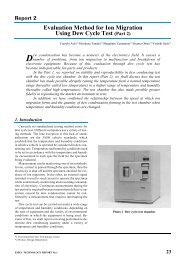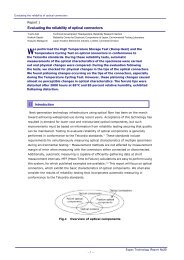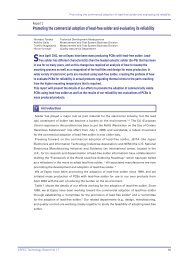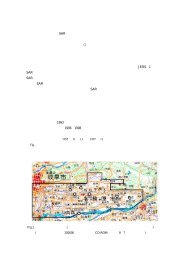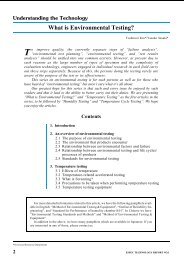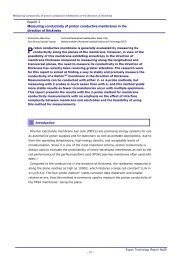Environmental improvement operations with Furusato no Mori (local ...
Environmental improvement operations with Furusato no Mori (local ...
Environmental improvement operations with Furusato no Mori (local ...
You also want an ePaper? Increase the reach of your titles
YUMPU automatically turns print PDFs into web optimized ePapers that Google loves.
<strong>Environmental</strong> <strong>improvement</strong> <strong>operations</strong> <strong>with</strong> <strong>Furusato</strong> <strong>no</strong> <strong>Mori</strong> (<strong>local</strong> forests)<br />
Report 3<br />
<strong>Environmental</strong> <strong>improvement</strong> <strong>operations</strong> <strong>with</strong> <strong>Furusato</strong> <strong>no</strong> <strong>Mori</strong> (<strong>local</strong> forests)<br />
Nobuyuki Eto, Hiroshi Otsuki, Emiko Hiki<strong>no</strong>, Kazumi Nishiyama, Keiichi Mura<strong>no</strong><br />
<strong>Environmental</strong> Management Department<br />
Within the vicissitudes of global environmental preservation, new detail is emerging on the<br />
role played by "greenery" and "forests." In particular, since the effectiveness of forests in<br />
absorbing carbon dioxide has been ack<strong>no</strong>wledged by the Kyoto protocol, the function of the<br />
forests in preserving the environment is coming to be seen as a crucial measure to prevent global<br />
warming. The reforestation of our living space, promoted by Espec, originates from our desire to<br />
bring about a pleasant environment giving life to the real functions of the forest. This report<br />
presents the soundproofing and carbon dioxide binding functions, two of the most basic<br />
environmental <strong>improvement</strong> functions of <strong>Furusato</strong> <strong>no</strong> <strong>Mori</strong> (<strong>local</strong> forests).<br />
1 Introduction<br />
Espec is publicizing environmental <strong>improvement</strong> activity as a keystone of environmental<br />
management. That viewpoint can be stated as "doing whatever helps to improve the<br />
environment," and in that spirit, the Espec Mic Corporation of the Espec Group has<br />
undertaken the challenge of reforesting our living space.<br />
The actual reforestation of our living space was carried out over three occasions of tree<br />
planting from 1999 through 2001 at Kobe Tech<strong>no</strong>complex (hereafter, KTC: the Kobe offices<br />
of our company). Our staff and their families, numbering about 1,100 persons participated in<br />
planting approximately 27,000 potted seedlings on 7,500 m2 .<br />
The Kyoto <strong>Environmental</strong> Measuring Center has initiated field investigations and research<br />
into the environmental <strong>improvement</strong> functions of this Espec forest.<br />
Fig.1 The Espec Forest<br />
ESPEC Tech<strong>no</strong>logy Report No.17 22
<strong>Environmental</strong> <strong>improvement</strong> <strong>operations</strong> <strong>with</strong> <strong>Furusato</strong> <strong>no</strong> <strong>Mori</strong> (<strong>local</strong> forests)<br />
23<br />
2 Reforesting our living space<br />
<strong>Furusato</strong> <strong>no</strong> <strong>Mori</strong> came about as a result of using the forest creation methods proposed and<br />
practiced by Dr. Akira Miyawaki, head of the Japanese Center for International Studies in<br />
Ecology.<br />
Almost all of the forests in the various areas of Japan have been affected by human<br />
intervention. Pristine nature remains only in a very few places such as in the groves of<br />
village shrines. Examining the natural vegetation in those few remaining sites has provided<br />
insight into their essential ecology (potential natural vegetation), and by adopting those<br />
types of trees in tree planting and trying to create regionally appropriate forests, it is<br />
possible to reforest our living space using <strong>local</strong> trees.<br />
Table 1 shows the distinctive features of this type of forest creation method. This method is<br />
used for the greening of a variety of areas, such as factories and roadways. 1)<br />
Table 1 Distinctive features and advantages of the <strong>Furusato</strong> <strong>no</strong> <strong>Mori</strong> method of reforesting our<br />
living space<br />
Uses potted seedlings 50 to 80 cm tall.<br />
Features Advantages<br />
Dense vegetation is planted (averaging 2 to 9<br />
trees per m 2 ).<br />
Comprised of various types of trees, <strong>with</strong> an<br />
emphasis on broad-leafed plants <strong>with</strong> a deep<br />
green luster.<br />
Immediately after tree planting, water<br />
sprinkling is necessary to avoid drying out, but<br />
after conditions stabilize almost <strong>no</strong><br />
maintenance is required.<br />
Tree planting is easier than when using<br />
conventional landscaping trees, and a higher<br />
percentage of trees take root. *1 It is also<br />
possible to plant on steep slopes.<br />
It is possible to very quickly form a forest<br />
ca<strong>no</strong>py, *2 which controls the growth of weeds<br />
and prevents the ground from drying out. This<br />
helps reduce maintenance such as mowing.<br />
Unlike artificial forests of cedar and cypress,<br />
these forests do <strong>no</strong>t cause hay fever.<br />
This is a low maintenance system.<br />
ESPEC Tech<strong>no</strong>logy Report No.17
<strong>Environmental</strong> <strong>improvement</strong> <strong>operations</strong> <strong>with</strong> <strong>Furusato</strong> <strong>no</strong> <strong>Mori</strong> (<strong>local</strong> forests)<br />
25<br />
Type of function<br />
Carbon dioxide absorption<br />
Prevention of surface erosion<br />
Prevention of surface layer<br />
breakdown<br />
Moderation of flooding<br />
Water resource reservoir<br />
Water purification<br />
Fossil fuel alternative<br />
Health rejuvenation<br />
Total<br />
Forest area<br />
Monetary value per 100 ha<br />
Table 3 Diverse functions and monetary value of forests 2)<br />
Monetary value of<br />
forests nationwide<br />
1.2391 billion yen<br />
28.2565 billion yen<br />
8.4421 billion yen<br />
6.4686 billion yen<br />
8.7407 billion yen<br />
14.6361 billion yen<br />
226.1 million yen<br />
2.2546 billion yen<br />
70.2638 billion yen<br />
2.5146 million ha<br />
279 million yen<br />
Method of determining value<br />
The value provided by forest carbon dioxide<br />
recovery is determined by the recovery cost<br />
of the same amount of carbon dioxide in a<br />
thermal power generation plant.<br />
The value provided by forest erosion control<br />
is determined by the cost of building dams<br />
to control erosion.<br />
The value of reduced surface area<br />
breakdown is determined by the cost of<br />
hillside construction.<br />
The value of the effectiveness of forests in<br />
reducing the amount of flooding is<br />
determined by taking the adjusted volume<br />
of probable rainfall for 100 years and adding<br />
the depreciation cost of flood control dams<br />
and annual maintenance costs.<br />
The value of the amount of basin reservoir<br />
provided by forest soil is determined by<br />
adding the depreciation cost of irrigation<br />
dams and annual maintenance costs.<br />
The value of water purification is<br />
determined by adding the depreciation cost<br />
of rainwater utilization facilities and annual<br />
maintenance costs.<br />
The value of the carbon fuel alternative<br />
effect provided by wood house building is<br />
determined by the cost of recovering that<br />
amount of carbon dioxide in a thermal<br />
power generation plant.<br />
The value of forest health rejuvenation is<br />
determined by the cost of travel to<br />
appreciate forest scenery.<br />
ESPEC Tech<strong>no</strong>logy Report No.17
<strong>Environmental</strong> <strong>improvement</strong> <strong>operations</strong> <strong>with</strong> <strong>Furusato</strong> <strong>no</strong> <strong>Mori</strong> (<strong>local</strong> forests)<br />
27<br />
Period constructed<br />
Planting surface<br />
area<br />
Constituent trees<br />
Density<br />
4-2-2 Method of measuring <strong>no</strong>ise<br />
Table 4 Summary of the Kashihara Bypass vegetation 1)<br />
Table 5 shows the <strong>no</strong>ise measurement method, and Fig.3 shows the <strong>no</strong>ise measurement<br />
points.<br />
Measurement<br />
section<br />
Measurement<br />
points<br />
Measurement<br />
conditions<br />
Measurements<br />
From 1981 to 1984<br />
24,600 ㎡<br />
Tall trees: six varieties of oak trees<br />
Medium trees: holly, Japanese ubame-gashi oak,<br />
camellia, and spindle tree (Euonymus japonica)<br />
Short trees: rhododendrum glabrius, Japanese<br />
pittosporum (Euchresta japonica), and Eurya japonica<br />
(Theaceae)<br />
Tall trees: 2 to 3 trees per ㎡<br />
Medium trees: 5 trees per ㎡<br />
Short trees: 11 trees per ㎡<br />
Photo 1 Kashihara Bypass<br />
Table 5 Noise measurement method<br />
No vegetation: Grasping the <strong>no</strong>ise damping effect of distance<br />
Low vegetation: Grasping the soundproofing effect of highway<br />
vegetation set out as a row of short trees forming a hedge<br />
<strong>Furusato</strong> <strong>no</strong> <strong>Mori</strong> vegetation: Grasping the soundproofing effect of<br />
highway vegetation created using the <strong>Furusato</strong> <strong>no</strong> <strong>Mori</strong> reforestation<br />
method<br />
Measurements were made at 3 points (0 m, 5 m, 10 m) from the edge<br />
of the roadway, which was the 0 m point, and the vegetation standing<br />
between the roadway and the 5 and 10 m measurement points.<br />
Noise meter: ordinary <strong>no</strong>ise meter; measurement height: 1.2 m;<br />
Frequency characteristics: A; Motion characteristics: fast<br />
Noise was measured seeking equal <strong>no</strong>ise levels from data of times of<br />
vehicular traffic.<br />
ESPEC Tech<strong>no</strong>logy Report No.17
4-2-3 Method of measuring results<br />
Table 6 and Fig.4 show the results of <strong>no</strong>ise measurements. Looking at the amount of <strong>no</strong>ise<br />
damping at the five meter point, we can see that low vegetation achieves almost -0.8 dB<br />
greater damping than at the <strong>no</strong> vegetation sites achieving damping by distance alone. The<br />
greatest difference was in the <strong>Furusato</strong> <strong>no</strong> <strong>Mori</strong> vegetation, which achieved -7.1 dB more<br />
damping.<br />
In sites mainly composed of the broad-leafed evergreen trees such as Quercus<br />
myrsinaefolia, an evergreen oak found in Japan and China, and other varieties of oak, the<br />
<strong>Furusato</strong> <strong>no</strong> <strong>Mori</strong> high-density vegetation exhibited highly superior soundproofing results.<br />
No vegetation<br />
Low vegetation<br />
<strong>Furusato</strong> <strong>no</strong> <strong>Mori</strong><br />
vegetation<br />
<strong>Environmental</strong> <strong>improvement</strong> <strong>operations</strong> <strong>with</strong> <strong>Furusato</strong> <strong>no</strong> <strong>Mori</strong> (<strong>local</strong> forests)<br />
Fig.3 Noise measurement points<br />
Table 6 Soundproofing measurements [Units: dB]<br />
Actual measured values<br />
Difference from 0 m<br />
Actual measured values<br />
Difference from 0 m<br />
Actual measured values<br />
Difference from 0 m<br />
0m 5m 10m<br />
ESPEC Tech<strong>no</strong>logy Report No.17 28<br />
76.9<br />
0<br />
76.8<br />
0<br />
77.2<br />
0<br />
69.8<br />
-7.1<br />
68.9<br />
-7.9<br />
63.0<br />
-14.2<br />
66.1<br />
-10.8<br />
66.4<br />
-10.4<br />
61.4<br />
-15.8
<strong>Environmental</strong> <strong>improvement</strong> <strong>operations</strong> <strong>with</strong> <strong>Furusato</strong> <strong>no</strong> <strong>Mori</strong> (<strong>local</strong> forests)<br />
29<br />
Fig.4 Noise measurement results<br />
4-2-4 Estimates of the soundproofing effect of the Espec forest<br />
At the slope in front of KTC facing the Chugoku highway, the tree height is currently 1 to 2<br />
meters, and there is almost <strong>no</strong> soundproofing effect. The <strong>no</strong>ise at point A3 in Fig.5 is<br />
approximately 75 dB. If the two rows of forested zones grow well, in 10 years the tree height<br />
is expected to reach 6 to 7 meters. 1) The types of trees composing the forest and the forest<br />
density differ slightly, but if we assume that this will achieve a similar soundproofing effect<br />
to that of the Kashihara Bypass highway vegetation, we can estimate that a single zone of<br />
trees will create a damping of -7 dB, and two zones will achieve a damping of -14 dB.<br />
Fig.6 presents examples of the effects of <strong>no</strong>ise levels on people. In the future, the<br />
soundproofing effect of the forest is predicted to suppress the effect of vehicular traffic <strong>no</strong>ise<br />
and create a pleasant work environment surrounded by the forest.<br />
Fig.5 Soundproofing effect of the Espec forest<br />
ESPEC Tech<strong>no</strong>logy Report No.17
<strong>Environmental</strong> <strong>improvement</strong> <strong>operations</strong> <strong>with</strong> <strong>Furusato</strong> <strong>no</strong> <strong>Mori</strong> (<strong>local</strong> forests)<br />
Fig.6 Noise evaluation<br />
ESPEC Tech<strong>no</strong>logy Report No.17 30
<strong>Environmental</strong> <strong>improvement</strong> <strong>operations</strong> <strong>with</strong> <strong>Furusato</strong> <strong>no</strong> <strong>Mori</strong> (<strong>local</strong> forests)<br />
35<br />
6 Conclusion<br />
We have presented trial calculations demonstrating the soundproofing effect and the<br />
amount of CO binding by the <strong>Furusato</strong> <strong>no</strong> <strong>Mori</strong>. Our investigation into this matter is still in<br />
2<br />
its initial stages, and we plan to carry this inquiry forward.<br />
Within the New Climate Change Policy Programme decided upon in 2002 to be promoted to<br />
counteract global warming, one of the countermeasures put forth was to promote the<br />
greening of cities. We would be delighted to have our readers consider the method of<br />
reforesting our living space as an activity contributing to society in the area of<br />
environmental management.<br />
7 Ack<strong>no</strong>wledgements<br />
We are grateful for the valuable advice we have received from Professor Kazue Fujiwara of<br />
the Graduate School of Environment and Information Sciences, Yokohama National<br />
University.<br />
[Termi<strong>no</strong>logy]<br />
*1 Percentage taking root<br />
The percentage of tree seedlings that take root after planting<br />
*2 Forming a forest ca<strong>no</strong>py<br />
The leaves and branches of the forest form a complete ca<strong>no</strong>py, and light can<strong>no</strong>t reach<br />
the forest floor.<br />
*3 Amounts of CO bound<br />
2<br />
The amount of forest existing for a given unit of surface area at a given point on a time<br />
axis. This generally forms a logistic curve.<br />
*4 Trunk lumber volume<br />
The volume of the tree trunk<br />
[Bibliography]<br />
1) "Theory and techniques of creating forests for environmental preservation," Japanese<br />
Center for International Studies in Ecology, 1995<br />
2) "Evaluating the multi-faceted functions of agriculture and forests in relation to the global<br />
environment and human life," The Science Council of Japan, Nov. 2001<br />
3) Akira Misawa, "The function of roadside greenery: the structure and impact of an<br />
environmental green belt," p.41-63, 1995<br />
4) Yasuo Tokita, "The environment and control tech<strong>no</strong>logy of sound: Vol.11, applied<br />
tech<strong>no</strong>logy," Fujtec Corporation, p.751-780, 1998<br />
5) "Reforestation manual for atmospheric purification," Council on compensation and<br />
prevention of pollution health issues, 1995<br />
6) "Tables of trunk lumber volumes in standing trees -West Japan edition-," J-FIC, 1998<br />
7) Kazue Fujiwara, "Mid-term report on research into the environmental purification<br />
functions of forests for environmental preservation in plants such as iron mills," Jan. 31,<br />
2001<br />
8) Kazue Fujiwara, "Research into the environmental purification functions of forests for<br />
environmental preservation in plants such as iron mills," 2002<br />
ESPEC Tech<strong>no</strong>logy Report No.17



